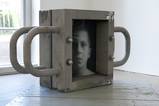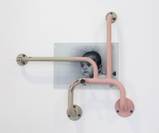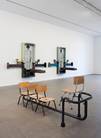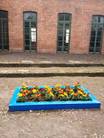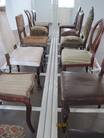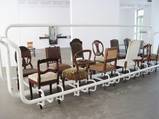Exhibitions 2013
Alexej Meschtschanow
 |
Alexej Meschtschanow, „Stuhl Nr. 4”, 2005. Stühle, Stahlrohr, Kunststoff, 78 x 56 x 173 cm. © Foto: Gunter Binsack |
The Anti-Gene
Objects/Sculptures
05. May – 07. July 2013
Opening on Sunday, May 5th, at 11.30 am.
Introduction: Veronika Olbrich, Ministry of Science and Culture, Hanover
Alexej Meschtschanow was born in Kiev in 1973, and now lives and works in Berlin. He studied at the Academy of Visual Arts in Leipzig between 1997 and 2005, and in 2008 was a master student at the Academy under Timm Rautert. At the Kunstverein Grafschaft-Bentheim, Meschtschanow developed an installation setting for the individual works. For the first time in his career, he also created an outdoor sculpture ("Rezidiv") that corresponds to the pieces in the exhibition rooms.
The Anti-Gene
MeMeschtschanow's objects, primarily furniture finds and photographic archive material, are often almost enclosed by dominant metal structures, detained, corrected, or even abused. Normal use of the furniture is made difficult by "supporting corsets" of white steel tubing frames, which act as a "ball and chain". Glazed portraits are pressed against the wall by projecting mounts so forcefully that the glass breaks, and the mounts also occasionally penetrate directly into the portraits. The ensemble of broken glass remains fixed, however, in its original shape.
The title for the exhibition "Das Gegengen" ("The Anti-Gene"), that Meschtschanow selected also for onomatopoeic aspects, refers to the decisive influence of human genes on the development of each individual. DNA is substantially in the forefront of the coordinates of an individual's developmental horizon, and determines their course of life. This genetic setting often prevents us from achieving ambitious goals in life. Learning processes that we would have to pass through on the way to the targeted ideal necessarily seem to counteract this instinct of self-preservation.
But in addition to the genes or the human instincts, an ideal development of the individual's personality is determined and limited heavily by external influences as well, as Meschtschanow's works of art show vividly. The rigid metal frames, for example, preventing a free or alternate arrangement of chairs, can stand as a metaphor for social constraints emanating from the school as an institution, the Church or the State, or the personal environment of each individual.
In one scene of the popular film "The Matrix," the underground revolutionary character Morpheus offers the protagonist Neo two pills: a blue or a red capsule. Taking the blue capsule means remaining as you are; the red, on the other hand, causes an intense shift in consciousness that brings dramatic changes in the quality of a person's mental and physical abilities. A beautiful possibility… Yet, since this red magic pill does not exist in reality, and you have to spend the rest of your life with yourself, a confrontation with one's genetic heritage is inevitable. (Translation: Taylor Champoux, Markus Pfeifer)
Supported by the city of Neuenhaus and the Lower Saxony Ministry for Science and Culture.
July 7th, 6 p.m
Finissage with artist talk / reading
Kyrill Koval , Edition "Nordhorn, Neuenhaus, Lingen 2011–2012" : His work is a combination of black and white photography of historic architecture alongside large areas of color / on display during the opening hours.
Parallel 22: Sarah Janssen, see here



